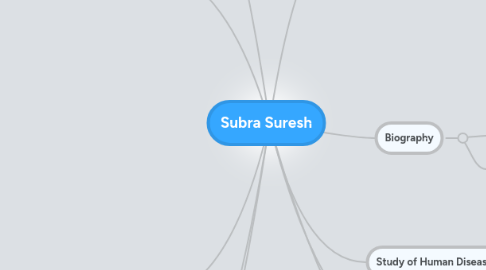
1. Applying Material Science Technology to Biological Systems
1.1. Advances in all different fields have allowed this research possible
2. Motivation
2.1. Biology
2.2. Imaging
2.3. Nanotechnology
2.4. Genetics
2.5. Public Health
2.6. Computational Science
2.7. Medicine
3. Plasmodium falciparum MALARIA
3.1. One of the most lethal infectious disease
3.2. Key Factors
3.3. Female needs protein - human blood
3.3.1. Injects sporozoits into blood
3.3.2. Goes to liver
3.3.3. Merozoites
3.3.3.1. Increase stickyness
3.3.3.2. Increase stiffness
3.3.3.2.1. Stick to the blood vessels
3.3.3.2.2. Impedes blood flow
3.4. Shine laser through the RBC to obtain width of the cell
3.5. Maleria prevents the cell from stretching
3.5.1. factor of 10-100
3.5.2. Immediate benefit... how much medication to give maleria patient depending on severity of stiff RBC
4. Hereditary Blood Disorders
4.1. Sickle Cell Anemia
4.1.1. How to demonstrate sickling at the single cell level
4.1.2. Deoxegenated state
4.1.2.1. go from globular to firbous shape
4.1.2.2. from disk shape to sickle shape
4.1.2.3. only in the deoxigenated state
4.1.3. We can show when oxygen is removed the cells become sickle
4.1.4. When oxygen is replenished, it retains it normal disk shape
4.2. Human Spleen
4.2.1. How does it work?
4.2.2. Synthetic spleen made of beads
4.2.3. Model spleen based of clinical practice
5. Cancer
5.1. Pancreatic
5.2. Breast
5.3. Leukemia
5.3.1. Purpose is to kill the white cells, it also kills other cells
5.3.2. When cells die, stiffness increase 30x
5.3.2.1. This can cause life threatening Leukostasis
5.3.2.2. Mechanical obstruction of blood vessels
5.3.2.3. Increased blood vessels
6. Study of Human Disease
6.1. Change a cellular property from healthy to diseased - what are the systematic changes?
6.1.1. Chemist looks at chmical properties
6.1.2. Biologist looks at cellular properties
6.1.3. KEY IS LOOK AT ALL ON A SYSTEM LEVEL
7. Engineer + Scientist
7.1. 240 articles
7.2. co-inventor 22 patents
7.3. 3 textbooks
7.4. Most frequently cited material scientist anywhere
8. Interdisciplinary
8.1. Mechanical
8.2. Bioengineering
8.3. Medicine
9. Biography
9.1. MIT Dean of College of Engineering
9.2. Awards
9.2.1. National Academy of Medicine
10. Human Red Blood Cell
10.1. Hemaglobin inside
10.2. 8um in diameter
10.3. 2um in height
10.4. model system for scientist
10.5. Why is engineering important?
10.5.1. smallest capillary in brain is 2um
10.5.2. How does 8um fit into this small space?
10.5.3. The cell lives in body 120 days
10.5.4. If it loses its ability to bend, you get disease
10.6. Has not been able to measure the full range of red blood cell functions
10.6.1. Membrane flickers on freq of nm time scale of ms
10.6.2. d
10.7. How does it move?
10.7.1. Simulation
10.7.2. How does it go through a tube in our brain?
10.7.3. PDMS microfluidic channel

